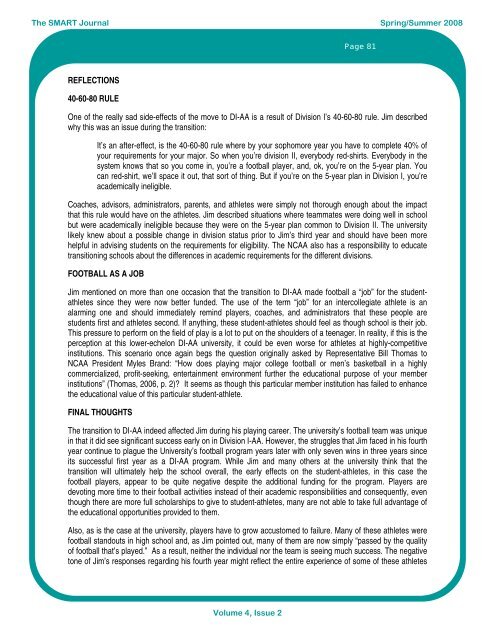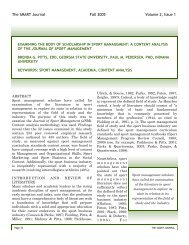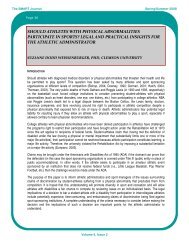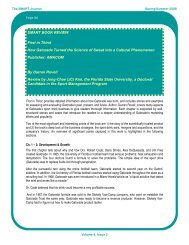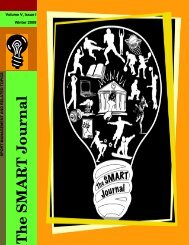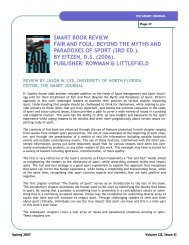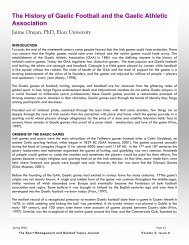Spring/Summer 2008 Volume 4, Issue 2 - The SMART Journal
Spring/Summer 2008 Volume 4, Issue 2 - The SMART Journal
Spring/Summer 2008 Volume 4, Issue 2 - The SMART Journal
You also want an ePaper? Increase the reach of your titles
YUMPU automatically turns print PDFs into web optimized ePapers that Google loves.
<strong>The</strong> <strong>SMART</strong> <strong>Journal</strong> <strong>Spring</strong>/<strong>Summer</strong> <strong>2008</strong><br />
Page 81<br />
REFLECTIONS<br />
40-60-80 RULE<br />
One of the really sad side-effects of the move to DI-AA is a result of Division I’s 40-60-80 rule. Jim described<br />
why this was an issue during the transition:<br />
It’s an after-effect, is the 40-60-80 rule where by your sophomore year you have to complete 40% of<br />
your requirements for your major. So when you’re division II, everybody red-shirts. Everybody in the<br />
system knows that so you come in, you’re a football player, and, ok, you’re on the 5-year plan. You<br />
can red-shirt, we’ll space it out, that sort of thing. But if you’re on the 5-year plan in Division I, you’re<br />
academically ineligible.<br />
Coaches, advisors, administrators, parents, and athletes were simply not thorough enough about the impact<br />
that this rule would have on the athletes. Jim described situations where teammates were doing well in school<br />
but were academically ineligible because they were on the 5-year plan common to Division II. <strong>The</strong> university<br />
likely knew about a possible change in division status prior to Jim’s third year and should have been more<br />
helpful in advising students on the requirements for eligibility. <strong>The</strong> NCAA also has a responsibility to educate<br />
transitioning schools about the differences in academic requirements for the different divisions.<br />
FOOTBALL AS A JOB<br />
Jim mentioned on more than one occasion that the transition to DI-AA made football a “job” for the studentathletes<br />
since they were now better funded. <strong>The</strong> use of the term “job” for an intercollegiate athlete is an<br />
alarming one and should immediately remind players, coaches, and administrators that these people are<br />
students first and athletes second. If anything, these student-athletes should feel as though school is their job.<br />
This pressure to perform on the field of play is a lot to put on the shoulders of a teenager. In reality, if this is the<br />
perception at this lower-echelon DI-AA university, it could be even worse for athletes at highly-competitive<br />
institutions. This scenario once again begs the question originally asked by Representative Bill Thomas to<br />
NCAA President Myles Brand: “How does playing major college football or men’s basketball in a highly<br />
commercialized, profit-seeking, entertainment environment further the educational purpose of your member<br />
institutions” (Thomas, 2006, p. 2)? It seems as though this particular member institution has failed to enhance<br />
the educational value of this particular student-athlete.<br />
FINAL THOUGHTS<br />
<strong>The</strong> transition to DI-AA indeed affected Jim during his playing career. <strong>The</strong> university’s football team was unique<br />
in that it did see significant success early on in Division I-AA. However, the struggles that Jim faced in his fourth<br />
year continue to plague the University’s football program years later with only seven wins in three years since<br />
its successful first year as a DI-AA program. While Jim and many others at the university think that the<br />
transition will ultimately help the school overall, the early effects on the student-athletes, in this case the<br />
football players, appear to be quite negative despite the additional funding for the program. Players are<br />
devoting more time to their football activities instead of their academic responsibilities and consequently, even<br />
though there are more full scholarships to give to student-athletes, many are not able to take full advantage of<br />
the educational opportunities provided to them.<br />
Also, as is the case at the university, players have to grow accustomed to failure. Many of these athletes were<br />
football standouts in high school and, as Jim pointed out, many of them are now simply “passed by the quality<br />
of football that’s played.” As a result, neither the individual nor the team is seeing much success. <strong>The</strong> negative<br />
tone of Jim’s responses regarding his fourth year might reflect the entire experience of some of these athletes<br />
<strong>Volume</strong> 4, <strong>Issue</strong> 2


